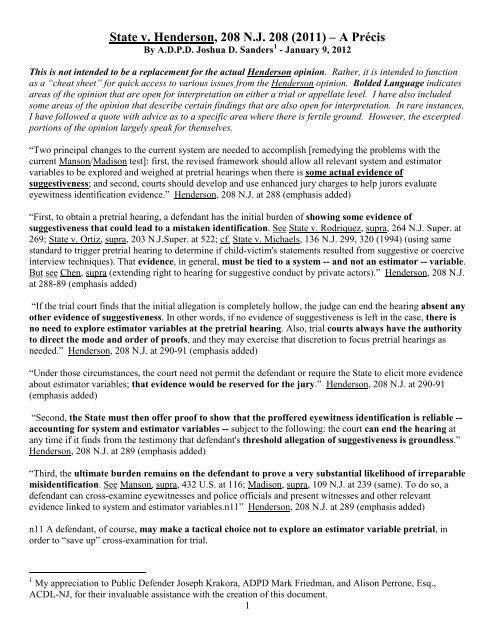State v. Henderson and the New Model Jury Charges - New Jersey ...
State v. Henderson and the New Model Jury Charges - New Jersey ...
State v. Henderson and the New Model Jury Charges - New Jersey ...
You also want an ePaper? Increase the reach of your titles
YUMPU automatically turns print PDFs into web optimized ePapers that Google loves.
<strong>State</strong> v. <strong>Henderson</strong>, 208 N.J. 208 (2011) – A Précis<br />
By A.D.P.D. Joshua D. S<strong>and</strong>ers 1 - January 9, 2012<br />
This is not intended to be a replacement for <strong>the</strong> actual <strong>Henderson</strong> opinion. Ra<strong>the</strong>r, it is intended to function<br />
as a “cheat sheet” for quick access to various issues from <strong>the</strong> <strong>Henderson</strong> opinion. Bolded Language indicates<br />
areas of <strong>the</strong> opinion that are open for interpretation on ei<strong>the</strong>r a trial or appellate level. I have also included<br />
some areas of <strong>the</strong> opinion that describe certain findings that are also open for interpretation. In rare instances,<br />
I have followed a quote with advice as to a specific area where <strong>the</strong>re is fertile ground. However, <strong>the</strong> excerpted<br />
portions of <strong>the</strong> opinion largely speak for <strong>the</strong>mselves.<br />
“Two principal changes to <strong>the</strong> current system are needed to accomplish [remedying <strong>the</strong> problems with <strong>the</strong><br />
current Manson/Madison test]: first, <strong>the</strong> revised framework should allow all relevant system <strong>and</strong> estimator<br />
variables to be explored <strong>and</strong> weighed at pretrial hearings when <strong>the</strong>re is some actual evidence of<br />
suggestiveness; <strong>and</strong> second, courts should develop <strong>and</strong> use enhanced jury charges to help jurors evaluate<br />
eyewitness identification evidence.” <strong>Henderson</strong>, 208 N.J. at 288 (emphasis added)<br />
“First, to obtain a pretrial hearing, a defendant has <strong>the</strong> initial burden of showing some evidence of<br />
suggestiveness that could lead to a mistaken identification. See <strong>State</strong> v. Rodriquez, supra, 264 N.J. Super. at<br />
269; <strong>State</strong> v. Ortiz, supra, 203 N.J.Super. at 522; cf. <strong>State</strong> v. Michaels, 136 N.J. 299, 320 (1994) (using same<br />
st<strong>and</strong>ard to trigger pretrial hearing to determine if child-victim's statements resulted from suggestive or coercive<br />
interview techniques). That evidence, in general, must be tied to a system -- <strong>and</strong> not an estimator -- variable.<br />
But see Chen, supra (extending right to hearing for suggestive conduct by private actors).” <strong>Henderson</strong>, 208 N.J.<br />
at 288-89 (emphasis added)<br />
“If <strong>the</strong> trial court finds that <strong>the</strong> initial allegation is completely hollow, <strong>the</strong> judge can end <strong>the</strong> hearing absent any<br />
o<strong>the</strong>r evidence of suggestiveness. In o<strong>the</strong>r words, if no evidence of suggestiveness is left in <strong>the</strong> case, <strong>the</strong>re is<br />
no need to explore estimator variables at <strong>the</strong> pretrial hearing. Also, trial courts always have <strong>the</strong> authority<br />
to direct <strong>the</strong> mode <strong>and</strong> order of proofs, <strong>and</strong> <strong>the</strong>y may exercise that discretion to focus pretrial hearings as<br />
needed.” <strong>Henderson</strong>, 208 N.J. at 290-91 (emphasis added)<br />
“Under those circumstances, <strong>the</strong> court need not permit <strong>the</strong> defendant or require <strong>the</strong> <strong>State</strong> to elicit more evidence<br />
about estimator variables; that evidence would be reserved for <strong>the</strong> jury.” <strong>Henderson</strong>, 208 N.J. at 290-91<br />
(emphasis added)<br />
“Second, <strong>the</strong> <strong>State</strong> must <strong>the</strong>n offer proof to show that <strong>the</strong> proffered eyewitness identification is reliable --<br />
accounting for system <strong>and</strong> estimator variables -- subject to <strong>the</strong> following: <strong>the</strong> court can end <strong>the</strong> hearing at<br />
any time if it finds from <strong>the</strong> testimony that defendant's threshold allegation of suggestiveness is groundless.”<br />
<strong>Henderson</strong>, 208 N.J. at 289 (emphasis added)<br />
“Third, <strong>the</strong> ultimate burden remains on <strong>the</strong> defendant to prove a very substantial likelihood of irreparable<br />
misidentification. See Manson, supra, 432 U.S. at 116; Madison, supra, 109 N.J. at 239 (same). To do so, a<br />
defendant can cross-examine eyewitnesses <strong>and</strong> police officials <strong>and</strong> present witnesses <strong>and</strong> o<strong>the</strong>r relevant<br />
evidence linked to system <strong>and</strong> estimator variables.n11” <strong>Henderson</strong>, 208 N.J. at 289 (emphasis added)<br />
n11 A defendant, of course, may make a tactical choice not to explore an estimator variable pretrial, in<br />
order to “save up” cross-examination for trial.<br />
1 My appreciation to Public Defender Joseph Krakora, ADPD Mark Friedman, <strong>and</strong> Alison Perrone, Esq.,<br />
ACDL-NJ, for <strong>the</strong>ir invaluable assistance with <strong>the</strong> creation of this document.<br />
1
















